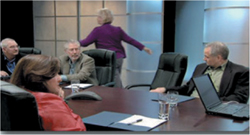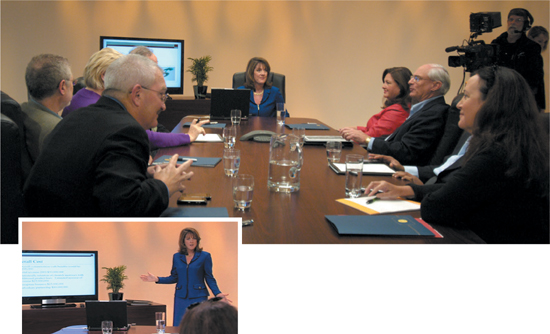CHAPTER
7
Decision Maker Leaves:
Reading the Room
You need to be cognizant of people’s eyeballs, all of them around the room.
—Steve Blank
If you’re starting to feel like you need to be a juggler to successfully present at the C-level, you’re not far off. And one of those balls you can’t lose track of, according to Steve Blank, is the ability to “understand when the context of the meeting has shifted around you and be able to move from ‘presentation mode’ into ‘process mode’.” Instead of focusing on content, you may need to take off your “presenter hat” and put on your “process hat.” That is, you stop to make sure that the way you are presenting your content is hitting the target. Presenters who can make this distinction will have a huge advantage at senior-level meetings.
Unfortunately, many presenters are so focused on their content that they don’t have the psychological bandwidth to be aware of what is going on in the room on an interpersonal level:
• Who is paying attention?
• Who is not?
• Who is taking it into the weeds?
• Who has time constraints?
• Who is being argumentative?
• Who is being supportive?
The list goes on and on. An effective top-level presenter has a kind of meeting ESP that allows him or her to constantly scan the room and make adjustments as necessary in real time. He or she is able to read the room and modify the flow of the content as necessary to accommodate changes in the moment. That skill is at the heart of facilitation.
Fail to notice what is going on in the room, like when the boss leaves in the middle of your presentation, and your presentation will be in big trouble. It happened to Sharon Black, District President, Robert Half International.

Sharon Black
Decision Maker Leaves:
“I’m very disappointed in myself.”
As a senior district president for RHI, Sharon oversees operations throughout northern and central California, Hawaii, Nevada, and Utah. She has been in the staffing industry for more than 25 years, and has held high-level positions in several other Bay Area staffing firms. She has been in her current position for four years.
In her presentation, Sharon’s goal was to get approval to hire a team of people to help the company work with their new subsidiary. If the executives approved this program, the revenue increase for the company would be about $25M, a huge ROI. Sharon expected most of the C-levels would be there, but especially the CEO who was critical to the decision-making process.
During the meeting, which was attended by Sharon’s boss as well as her mentor, Sharon sat at the head of the table in front of her computer immersed in the data. She hadn’t even gotten through her third point when the CEO gestured to one of the executives across from her, whispered something to him, and then left the room. Sharon failed to notice.

The CEO’s departure had to be brought to her attention. “What would you like me to do?” Sharon asked, her composure clearly rattled. The rambling, unfocused discussion among the remaining executives at the table after the CEO left made things worse. Sharon did not get the clear decision she wanted. She knew she’d blown it “I was so focused on my content that I was not aware of what else was happening around the room. I was not watching what the audience was doing. I did not notice when the CEO left the room, and she’s the decision maker. Honestly, I’m very disappointed in myself.”

Sharon’s first faux pas was sitting down with the executives. Taking a seat at the head of the table made things much worse. That’s the power position. Instead of being appropriately deferential, Sharon had inadvertently signaled disrespect by assuming the role of an equal rather than that of a presenter. Of course, sitting rather than standing wasn’t her only mistake.
Executive Advice:
If I get up to leave, I prefer that they stop me and ask, ‘Do you want to continue?’ or ‘What do we need to do here?’
—Brenda Rhodes
Don’t assume you can’t get a decision. Most of the time the key decision maker is unwilling to hold up a consensus just because he or she had to duck out for something.
—Harold Fethe
During the meeting, Sharon needed to be aware that she was about to lose her audience and address that instead of focusing so intently on her slides. At the beginning of the meeting, she should have acknowledged the CEO’s attendance. Simply saying, “Brenda, thank you for joining us,” would have made it more difficult for Brenda to slip away.
Paying Attention Pays Off
When Sharon did her presentation a second time, she stood up. This allowed her to read the room and tune into to her audience’s nonverbal communication. She said, “I made sure that they were engaged with me, not looking at their smartphones.” When Brenda got up to leave, Sharon noticed what was happening.

“Brenda, I see you have to leave. What would you like me to do?” she asked, interrupting her own presentation. “I’d be happy to reschedule for another meeting, or wait until you come back.” Brenda simply asked that she pause for a moment until she returned. This time around, the meeting ended successfully for Sharon.
Summary
To avoid the traps of Decision Maker Leaves:
• Read the room
• Focus on the decision maker
• Ask the decision maker what to do as he or she is getting up to leave
• Check with the group about what to do if the decision maker hasn’t made it clear
